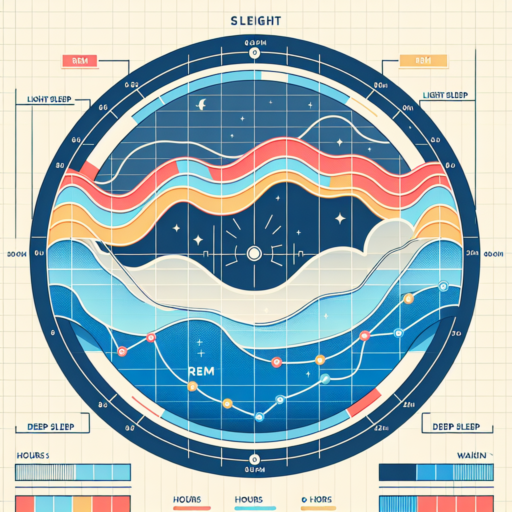What should a healthy sleep cycle look like?
Understanding the intricacies of a healthy sleep cycle is pivotal for maintaining optimal physical and mental health. A healthy sleep cycle, often referred to as the circadian rhythm, typically includes four to six sleep cycles, each lasting approximately 90 to 110 minutes. These cycles are composed of different sleep stages, including light sleep, deep sleep, and REM (Rapid Eye Movement) sleep.
Deep sleep plays a crucial role in physical recovery, immune function, and growth hormone release. It’s in this stage that the body repairs and regrows tissues, builds bone and muscle, and strengthens the immune system. Conversely, REM sleep is essential for cognitive functions, such as memory consolidation, learning, and emotional processing. This phase is characterized by rapid eye movements, increased brain activity, and vivid dreams.
For an adult, aiming for 7 to 9 hours of quality sleep per night is generally recommended. This duration not only supports the completion of the necessary sleep cycles for restoration and recovery but also aids in sustaining a healthy balance between deep sleep and REM sleep. By maintaining consistent sleep and wake times, even on weekends, one can encourage a more regular and efficient sleep cycle.
What percentage of sleep should be in each cycle?
Understanding the distribution of sleep cycles can significantly enhance the quality of your rest. Essentially, sleep is divided into multiple cycles, each comprising of distinct stages including light sleep, deep sleep, and REM (Rapid Eye Movement) sleep. The goal for most adults is to cycle through these stages several times each night, but knowing what percentage of sleep should be in each cycle can help optimize your sleep pattern for better health and productivity.
Light sleep, which serves as a gateway to deeper stages of sleep, typically accounts for 45-55% of your total night’s sleep. During this phase, your body starts to relax, and your heart rate and breathing slow down. It’s a foundational part of the sleep cycle, helping to transition you into deeper restorative stages.
Deep sleep is crucial for physical recovery and growth, immune function, and energy restoration. It usually represents 13-23% of your sleep. This is when the body repairs muscles and tissues, stimulates growth and development, and boosts immune function. Achieving sufficient deep sleep is vital for feeling refreshed and alert the next day.
REM sleep, known for its association with dreaming, should constitute approximately 20-25% of your nightly sleep. This phase is crucial for cognitive functions such as memory, learning, and creativity. During REM, the brain processes and consolidates information from the day, which is essential for memory formation and problem-solving abilities.
No se han encontrado productos.
What is a good sleep cycle score?
Understanding the quality of your sleep can significantly enhance your overall health and wellbeing. A good sleep cycle score is essentially a metric used to assess this quality, with various smart devices and apps providing users with insights into their sleep patterns.
Components of a Good Sleep Cycle Score
The score typically takes into account several components, including the amount of time spent in different sleep stages such as light, deep, and REM sleep, the number of awakenings, and the total duration of sleep. A higher score often indicates a restful and uninterrupted sleep, suggesting that the sleeper has successfully cycled through the necessary stages of sleep multiple times throughout the night.
To achieve a good sleep cycle score, experts recommend aiming for a balanced distribution of sleep stages, with particular emphasis on deep and REM sleep. These stages are crucial for physical restoration and memory consolidation, respectively. Additionally, minimizing the number of awakenings and ensuring a total sleep duration of 7 to 9 hours for adults can significantly impact the score.
While the exact criteria for what constitutes a «good» score may vary between different tracking systems, consistently achieving scores within the higher range can be an indicator of good sleep health. Keep in mind, though, that qualitative aspects of sleep, including how refreshed one feels upon waking, are equally important and should not be overlooked.
What is the best sleep cycle intervals?
Understanding the best sleep cycle intervals is crucial for enhancing overall sleep quality and ensuring you wake up feeling refreshed. The human sleep cycle consists of several stages, each playing a significant role in restorative processes. While individual needs may vary, research suggests that certain patterns can benefit most people.
Traditionally, sleep cycles are approximately 90 minutes long, encompassing both Rapid Eye Movement (REM) and Non-REM (NREM) stages. For optimal rest, it is recommended to aim for about 5-6 of these cycles per night, which translates to 7.5 – 9 hours of sleep.
However, not all sleep intervals create equal benefits. The quality of sleep within these intervals, particularly the time spent in deep and REM sleep, is vital. Monitoring sleep patterns through wearable technology or sleep tracking apps can help identify your ideal sleep cycle intervals, allowing for adjustments to bedtime or wake-up times to maximize sleep efficiency.




